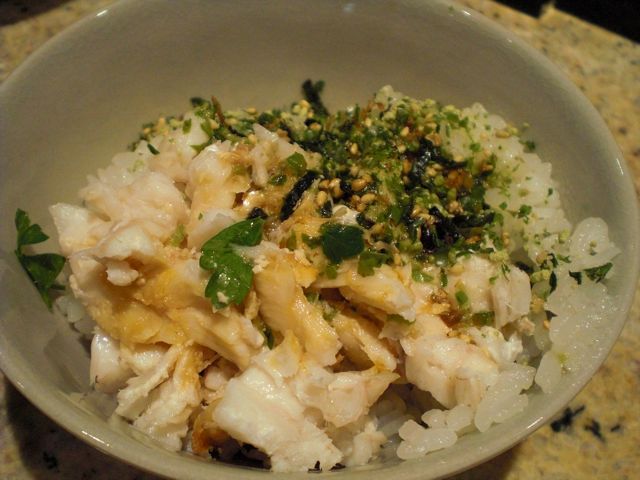Among the whole fish they had, the red snapper looked the best, although many were very large. We ended up buying one of the smaller ones but it was still big (over 5 and a half pounds). I have never cooked red snapper this large before.
So, I decided to honor this fish monger's effort by salting the fins heavily (called "kazarijio" 飾り塩or decorative salting and protecting them with aluminum foil like you see on the left for pectoral fins (middle) and the tail (bottom). The rest of the fish including the skin and cavity were also salted but not too heavily. I decided not to use any lemons or other herbs in the cavity as per Japanese tradition. We deviated from tradition, however, after I made the comment that generally this type of white meat fish can be very bland. My wife suggested since we were already grilling it we should add hot smoking. I protested, "Smoking grilled fish was not traditional." But what the heck, I decide to do it.
Because the fish was so big it just barely fit into our Weber grill (there was no room to make "hot" to "cool" zones so I could move the fish between them as it cooked). I decided to use indirect heat like I do for whole chickens. This was another departure from the traditional Japanese way of grilling this type of fish. They are usually grilled over direct heat but I was concerned that if I used direct heat, the skin would be completely charred before the thickest part of the fish was done. As before, I used lump charcoal divided into two baskets on the left and right sides of the grill. I placed the fish in the center. I used soaked apple wood chips for the hot smoking. I cooked the fish for about 35 minutes (it was slightly underdone but only the meat around the back bone needed more cooking. See below.)
Before grilling, the skin is usually scored (decoratively) to prevent it from rupturing in a random fashion. I forgot to do this. As you will notice in the first picture, the skin split along the dorsal fin area (which was tactically covered by sprigs of parsley for the picture). My wife's theory is that this was fortuitous because the intact skin during cooking may have made the meat very moist but I am not sure. Despite the smoking, the skin retained its red color. Please notice the intact pectoral fin.
This is by far and away the best red snapper or "tai" fish I have ever tasted. All of the grilled red fish I had in Japan were much smaller and totally overcooked. As a result they were rather dry and tasteless. This one is so flavorful (hot smoking helped), juicy and just excellent! We started snacking on it before we even got portions cut. We found ourselves standing over the fish, tasting morsels and exclaiming at how unimaginably good it was. We finally got control of ourselves and put some on a plate. So we actually ate 3 times more than what you see in the picture below. Since I did not use direct fire, the skin was not very crispy; it was actually fairly leathery and not good to eat (small concession).
Before I started grilling this fish, my wife suggested I make some spicy sauces which would make this white meat fish more exciting. It turned out, the fish was so good we really did not need any sauces. Nonetheless I made two sauces. One was grated diakon with 7 favored Japanese red pepper flakes 七味唐辛子 and ponzu (ponzu-shouyu ポン酢醤油), the other was "negi sauce" 葱ソース or scallion sauce, which is a mixture of lots of chopped scallion, soy sauce, sesame oil, mirin, and a dash of tabasco (in the small blue cup in the picture above). The ponzu-grated daikon sauce was way too harsh and spicy (mostly due to the daikon) but the negi sauce was good.
The meat around the bone was now cooked and the juice was browned on the bottom of the pan. After I removed the meat from the bone, I added small amount of water and sake to deglaze the brown bits. I tasted it. It had enough saltiness and made a nice broth.
I added the meat to the hot rice as seen below. Since I had "rice seasoning" or "frikake" ふりかけwith a wasabi flavor (contains sesame seeds, nori etc as well), I sprinkled it over the rice. Then, I poured on a small amount of the broth (2-3 tbs).

This is not a true "tai chazuke" 鯛茶漬 but the combination worked well as a shime 〆dish. Since this was rather hot day, our cold house sake "mu" with its clean crisp taste was perfect. We have lots of leftover fish meat including the head. I may have to come up with some new dishes.


No comments:
Post a Comment